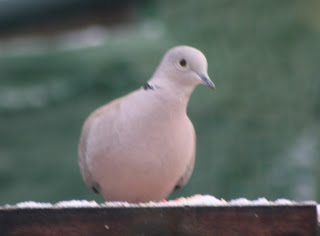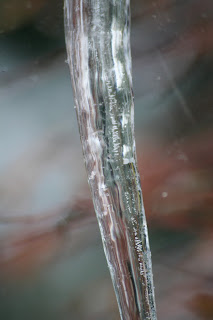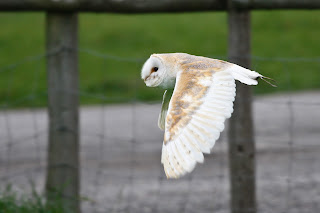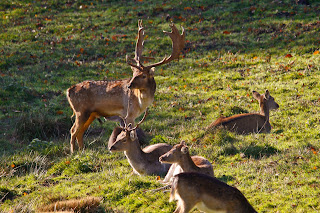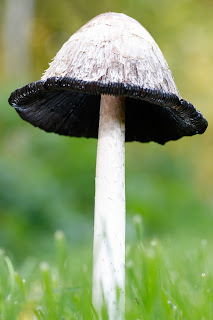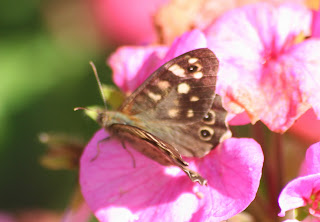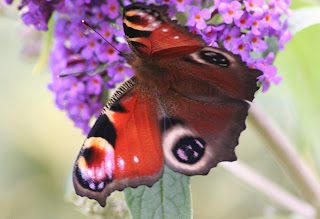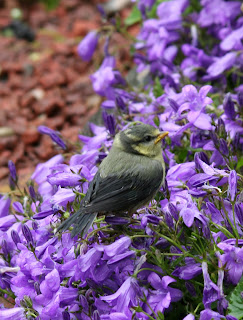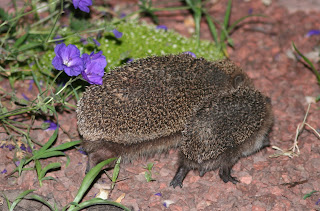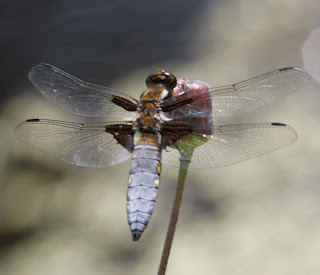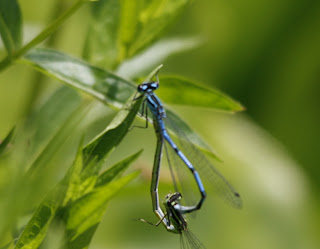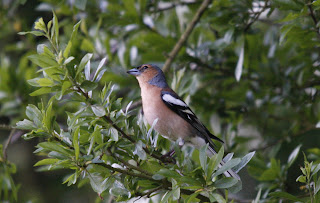"Holly berries shinning red, mean along winter, ti's said."
We do have lots of berries in the hedges around here and we have had snow early. The saying seems to be true this year at least.
1st Snowing but not very heavy. Some of the country has had 18 inches of snow and temperatures of -20. So far we have had it mild. Lots of birds coming for food. A thrush is eating a snail, first bashing it on the ground to get it out of it's shell.
2nd More snow and a visit by the great spotted woodpecker. He likes to eat the fat and seed out of the coconut shell on the stem of the bird table.
13th The snow has gone 2 male blackbirds are eating the pyracantha berries and apples I have put out. They have regular fights chasing each other from the garden. Starlings, robins, blue, great and cole tits , sparrows and magpies and collared doves coming everyday.
Collared Dove ( Streptopelia decaocto) Usually found in towns or on farmland. Nests on buildings or in trees. Lays 2 white eggs and can have 2 broods. Feeds on grain,seed and some fruit.
16th More snow but it didn't stick. 3 male blackbirds in the garden and a female. They are tolerated for a while before 1 of the blackbirds chases the others including the female off.
17th Lot's more snow falling today. A hard frost has created beautiful scenery this long icicle.
The river where I see the Kingfisher is beautiful.
22nd It's the coldest December in 30 years according to the met office. There has certainly been more snow that I can remember. All the birds are fluffed up against the cold and are visiting regulary.
31st December ends cold and murky, but the snow has gone. It has been the coldest December for 100 years.
Frosty trees, icicles form, and a rose frozen in time.
Friday 31 December 2010
Tuesday 30 November 2010
November part 2
19th Visit to wildlife area in Cambridge to see the starlings unfortunately the weather is foggy. The starling perform beautifully - undulating like a swarm, or like fish in the sea. Suddenly a waterfall of birds as they go to roost. Fab! On the way I saw my first wild barn owl in Field nearby the roost.
Barn Owl (Tyto alba) Hunting silently using sight and sound to locate their prey, shrews, mice, voles and frogs. They lay 4-6 white eggs and may have 2 broods.
"The Owl that watching in the barn ,
sees the mouse creeping in the corn." ...Samuel Butler
Last week in November and it has turned winter cold. A robin sits a perch fluffed up for ages just watching then defending his territory against the sparrows. A woodpecker appears 3 gardens away.
Snow - the coldest spell in 17 years. Lots of visitors to the garden looking for food including the woodpecker.
Great Spotted Woodpecker (Dendrocopos major)
At home in both conifer and broadleaved woodland. Lays 4-7 glossy white eggs. Feeds on larvae. beetles, wasps, moths and sometimes small birds. He lands at the bottom of the bird table and works his way up to the food.
"Rap, rap, rap, rap. I hear thy knocking bill." ...Montgomery
Barn Owl (Tyto alba) Hunting silently using sight and sound to locate their prey, shrews, mice, voles and frogs. They lay 4-6 white eggs and may have 2 broods.
"The Owl that watching in the barn ,
sees the mouse creeping in the corn." ...Samuel Butler
Last week in November and it has turned winter cold. A robin sits a perch fluffed up for ages just watching then defending his territory against the sparrows. A woodpecker appears 3 gardens away.
Snow - the coldest spell in 17 years. Lots of visitors to the garden looking for food including the woodpecker.
Great Spotted Woodpecker (Dendrocopos major)
At home in both conifer and broadleaved woodland. Lays 4-7 glossy white eggs. Feeds on larvae. beetles, wasps, moths and sometimes small birds. He lands at the bottom of the bird table and works his way up to the food.
"Rap, rap, rap, rap. I hear thy knocking bill." ...Montgomery
Tuesday 16 November 2010
November part 1
"Ice in November to bear a duck,
The rest of the year will be slush and muck."
The first week has been a lot milder than expected. Sunny with a nip in the air with no bad frost yet. The amazing autumn colour continues.
The crows and magpies are very noisey at the moment and the gang of sparrows are fighting all the time. More sparrows kill other sparrows than anything else. By the river the himalayan balsam has been cut down and the rubbish has been cleaned up. No sightings of the kingfisher sadly.
The second week has been windy and cold the leaves are mostly gone. Visitors to the garden include starlings, magpies, blue and great tits, collared doves, pigeons, sparrows and a robin.
16th We visit the New Forest. The colours have faded to a general russet brown with braken covering the floor.
The Fallow Deer were in the clearing looking peaceful together as the rutt is over. The stags still look magestic.
Fallow Deer(Cervus dama)
Lots of variation in colours some are chestnut brown other blacker while others are quite pale. The does can have offspring in her second year and will have a foal every year for up to 10 years.
The rest of the year will be slush and muck."
The first week has been a lot milder than expected. Sunny with a nip in the air with no bad frost yet. The amazing autumn colour continues.
The crows and magpies are very noisey at the moment and the gang of sparrows are fighting all the time. More sparrows kill other sparrows than anything else. By the river the himalayan balsam has been cut down and the rubbish has been cleaned up. No sightings of the kingfisher sadly.
The second week has been windy and cold the leaves are mostly gone. Visitors to the garden include starlings, magpies, blue and great tits, collared doves, pigeons, sparrows and a robin.
16th We visit the New Forest. The colours have faded to a general russet brown with braken covering the floor.
The Fallow Deer were in the clearing looking peaceful together as the rutt is over. The stags still look magestic.
Fallow Deer(Cervus dama)
Lots of variation in colours some are chestnut brown other blacker while others are quite pale. The does can have offspring in her second year and will have a foal every year for up to 10 years.
Saturday 16 October 2010
October part 4
We are also visited by a wren. The Wren (Troglodytes troglodytes) is the second smallest bird here. The male will build several nests and may have more than one mate. She will lay white eggs with red/brown spots and may have 2 broods. They eat insects and seeds.
At a local castle a robin and chaffinch come down to share our food.
On the grass a mushroom grew. At the start of the week it looks like this.
By the end of the week it looks like this.
The Shaggy Ink Cap (Coprinus comatus) 6-14cm high it grows in gardens. Named after the shaggy scales on its surface. The cap drips away as an inky fluid that contains the spores.
By the end of the week the autumn colours are even more impressive. Pale yellow leaves in some taller trees show bright green mistletoe in their branches. Other trees are covered in brandy snap colours which looks burnt at the edges with darker reds on the outside of orange. October ends mild for the time of year .
At a local castle a robin and chaffinch come down to share our food.
On the grass a mushroom grew. At the start of the week it looks like this.
By the end of the week it looks like this.
The Shaggy Ink Cap (Coprinus comatus) 6-14cm high it grows in gardens. Named after the shaggy scales on its surface. The cap drips away as an inky fluid that contains the spores.
By the end of the week the autumn colours are even more impressive. Pale yellow leaves in some taller trees show bright green mistletoe in their branches. Other trees are covered in brandy snap colours which looks burnt at the edges with darker reds on the outside of orange. October ends mild for the time of year .
Friday 15 October 2010
October part 3
15th Lots of activity in he garden - a gang of sparrows, robin, a young pigeon eating berries, 5 blue tits and a cole tit.
The last week of October we return to the cottage in Shropshire. Leading up to the cottage a covering of leaves gives off a bejewelled glow on the ground where the sunlight hits them below the trees canopy. Lots of pheasants around making a commotion. I saw 18 in the field all strutting their stuff while at the same time looking around anxiously. it is hunting season.
Pheasant (Phasianus colchicus). The Pheasants true home is Asia it was introduced here in the 18th century.It is well established as a wild bird but is also breed for hunting. The hen is less colourful and lays 8-15 pale olive eggs. They feed on fruit, seeds, leaves, insects, lizards, field voles and small birds.
.The Buzzards also pronounce their ownership of the skies above.
They are majestic and come quite close banking then flying away. One lands in a tree close by.
Rain tracks across the field opposite with the sun shining there is a magical glow. The trees look they are lit with fairy lights.
The last week of October we return to the cottage in Shropshire. Leading up to the cottage a covering of leaves gives off a bejewelled glow on the ground where the sunlight hits them below the trees canopy. Lots of pheasants around making a commotion. I saw 18 in the field all strutting their stuff while at the same time looking around anxiously. it is hunting season.
Pheasant (Phasianus colchicus). The Pheasants true home is Asia it was introduced here in the 18th century.It is well established as a wild bird but is also breed for hunting. The hen is less colourful and lays 8-15 pale olive eggs. They feed on fruit, seeds, leaves, insects, lizards, field voles and small birds.
.The Buzzards also pronounce their ownership of the skies above.
They are majestic and come quite close banking then flying away. One lands in a tree close by.
Rain tracks across the field opposite with the sun shining there is a magical glow. The trees look they are lit with fairy lights.
Friday 8 October 2010
october part 2
More from Slimbridge.
Golden eye ( Bucephala clangula).
Winter visitors that don't breed here. Feeds on small water animals, mostly shellfish and insects.
"He of white-cheeks, and Golden-eyed,
Of white and black alternate pied. ... Bishop Mant
We also saw lots of other ducks- I'm not good at identifying ducks but I'm learning.
However my favourite place was the kingfisher hide even without a kingfisher. Lots of dragonflies zipped around on the bend of the river while tits and finches came to the bird feeder by the wooded area.
Golden eye ( Bucephala clangula).
Winter visitors that don't breed here. Feeds on small water animals, mostly shellfish and insects.
"He of white-cheeks, and Golden-eyed,
Of white and black alternate pied. ... Bishop Mant
We also saw lots of other ducks- I'm not good at identifying ducks but I'm learning.
However my favourite place was the kingfisher hide even without a kingfisher. Lots of dragonflies zipped around on the bend of the river while tits and finches came to the bird feeder by the wooded area.
Thursday 7 October 2010
October part 1
"In the old of the moon
A cloudy morning
Bodes a fair afternoon."
1st October has opened with rain, rain and more rain. The sparrowhawk landed on the swingy chair in the corner of the garden but no small birds were to be found.
4th Used a bat detector in the garden - saw and heard 2 bats on 45khz. Pipistrells I think.
7th Saw a "charm" of goldfinch by the river and mallards fighting.
We went to Slimbridge at the weekend (cheating a little I know) but we took lots of pictures.
Eider duck (Somateria mollissima).
Found from the Artic to Britian. Eats mollusc's and crustacea. Lays 4-6 light green eggs in nests on the ground.
Wigeon (Anas penelope). Only breeding in Scotland. Lays 7-8 creamy buff eggs. Feeds on grass and grain
A cloudy morning
Bodes a fair afternoon."
1st October has opened with rain, rain and more rain. The sparrowhawk landed on the swingy chair in the corner of the garden but no small birds were to be found.
4th Used a bat detector in the garden - saw and heard 2 bats on 45khz. Pipistrells I think.
7th Saw a "charm" of goldfinch by the river and mallards fighting.
We went to Slimbridge at the weekend (cheating a little I know) but we took lots of pictures.
Eider duck (Somateria mollissima).
Found from the Artic to Britian. Eats mollusc's and crustacea. Lays 4-6 light green eggs in nests on the ground.
Wigeon (Anas penelope). Only breeding in Scotland. Lays 7-8 creamy buff eggs. Feeds on grass and grain
Saturday 25 September 2010
September part 3
8th Squirrel in garden.
At the river the kingfisher zips past us at 7:30.
12th Various tits , sparrows, magpies and collared doves visiting garden. A mouse scampers around.
24th Lightening lights up the sky.
25th Another walk along the river bank ( I'm obsessed with that blue bird). Did see a dragonfly, heron and a buzzard overhead. A swan and her cygnets floated along by the park.
Mute Swan ( cygnus olor) Identified by the orange bill. Legend says Richard th Lion Heart brought the swans back from the crusades. Unmarked swans on the Thames are owned by the Queen. Both sexes are alike. They feed on water vegetation and lay 5-7 eggs.
26th Conkers are falling from the trees and it is cold autumn is around the corner.
27th 2 squirrels fighting in garden. 2 wrens flitting back and forth by the river and a grey wagtail stands on a rock in te middle of the river.
30th September ends with a day of sun after a day of rain.
At the river the kingfisher zips past us at 7:30.
12th Various tits , sparrows, magpies and collared doves visiting garden. A mouse scampers around.
24th Lightening lights up the sky.
25th Another walk along the river bank ( I'm obsessed with that blue bird). Did see a dragonfly, heron and a buzzard overhead. A swan and her cygnets floated along by the park.
Mute Swan ( cygnus olor) Identified by the orange bill. Legend says Richard th Lion Heart brought the swans back from the crusades. Unmarked swans on the Thames are owned by the Queen. Both sexes are alike. They feed on water vegetation and lay 5-7 eggs.
26th Conkers are falling from the trees and it is cold autumn is around the corner.
27th 2 squirrels fighting in garden. 2 wrens flitting back and forth by the river and a grey wagtail stands on a rock in te middle of the river.
30th September ends with a day of sun after a day of rain.
Tuesday 7 September 2010
September part 2
6th We go back to the river but no sign of the kingfisher. We did see rats and herons. At home the hedgehog is also absent as are the blackbirds. However we are still seeing sparrows, robins, pigeons,collared doves, magpies and blue and great tits.
7th spent some of the day watching a variety of tits perching in the blossom tree before coming to the bird table. Then they all dive for cover! A sparrowhawk lands in the garden.
Sparrow Hawk (Accipter nisus)
Usually seen in forests and woods. the female is larger than the male. They can kill birds a sbig as pigeons but normally eat finches , tits, sparrows, mice, voles, and young rabbits. They lay 4-6 eggs.
7th spent some of the day watching a variety of tits perching in the blossom tree before coming to the bird table. Then they all dive for cover! A sparrowhawk lands in the garden.
Sparrow Hawk (Accipter nisus)
Usually seen in forests and woods. the female is larger than the male. They can kill birds a sbig as pigeons but normally eat finches , tits, sparrows, mice, voles, and young rabbits. They lay 4-6 eggs.
Thursday 2 September 2010
September part 1
"September blows soft till the fruits in the loft."
1st starts sunny and warm. both the old and young robin have been today along with the sparrows and the collared doves and lots of brown and white butterflies.
Speckled wood (Pararge aegeria)
In flight from March. The caterpillar is darkgreen and yellow stripped. In Europe the spots are orange here they are creamy white.
2nd Went for a walk along the river after tea, saw some mallard ducks, a heron, which flew over us before landing in the river to fish. Best of all however we had 3 sightings of a kingfisher. The flash of blue and red was unmistakeable. To fast for a picture sadly. We also saw a lardge red dragonlfy catch food on the wing.
1st starts sunny and warm. both the old and young robin have been today along with the sparrows and the collared doves and lots of brown and white butterflies.
Speckled wood (Pararge aegeria)
In flight from March. The caterpillar is darkgreen and yellow stripped. In Europe the spots are orange here they are creamy white.
2nd Went for a walk along the river after tea, saw some mallard ducks, a heron, which flew over us before landing in the river to fish. Best of all however we had 3 sightings of a kingfisher. The flash of blue and red was unmistakeable. To fast for a picture sadly. We also saw a lardge red dragonlfy catch food on the wing.
Tuesday 31 August 2010
August Part 4
14th The blackberry is bearing fruit and the pryracantha berries are starting to turn orange. Still a couple of day's to go but St Swithan semms to have got it right with subshine and showers for 40 days.
22nd ate blackberry and apple pie. yum.
"If the 24th of august be fair and clear, then hope for a properous autumn that year."
24th wasnt fair and clear so not a properous autumn unless you are wildlife as all the hedges seem filled with berries .
26th Squirrel in garden. It is very wet.
27th Young robin seems to be visiting the garden with the sparrows.
28th Adult robin in garden looking ready for his christmas card photo's. 3 great tits also looking very smart.
31st Sunny end to August.
22nd ate blackberry and apple pie. yum.
"If the 24th of august be fair and clear, then hope for a properous autumn that year."
24th wasnt fair and clear so not a properous autumn unless you are wildlife as all the hedges seem filled with berries .
26th Squirrel in garden. It is very wet.
27th Young robin seems to be visiting the garden with the sparrows.
28th Adult robin in garden looking ready for his christmas card photo's. 3 great tits also looking very smart.
31st Sunny end to August.
Thursday 12 August 2010
August part 3
7th Two young robins are in the garden eating meal worms. The peace does'nt last long before one chases off the other.
8th One of the robins is back sitting on the fence bobbing up and down as if the garden is now his. The two collared doves have had a good feed from the table. A young pigeon has arrived- it doesn't have the white patches on it's neck like mum and dad.
We have put a hedgehog box out with food inside. Only a cats nose pokes in at the entrrance.
Picked the last of my raspberries and cut the old canes down, the new canes already look strong so i hope next year's crop will be good.
12th Baby frogs jumping around in garden and resting in the undergrowth. Butterflies are feeding on the buddleia.
A dragonfly came into the conservatory.
Goldenringed Dragonfly
100mm a hawk will hover over small streams from May- Sept.
8th One of the robins is back sitting on the fence bobbing up and down as if the garden is now his. The two collared doves have had a good feed from the table. A young pigeon has arrived- it doesn't have the white patches on it's neck like mum and dad.
We have put a hedgehog box out with food inside. Only a cats nose pokes in at the entrrance.
Picked the last of my raspberries and cut the old canes down, the new canes already look strong so i hope next year's crop will be good.
12th Baby frogs jumping around in garden and resting in the undergrowth. Butterflies are feeding on the buddleia.
A dragonfly came into the conservatory.
Goldenringed Dragonfly
100mm a hawk will hover over small streams from May- Sept.
Tuesday 3 August 2010
August part 2
3rd Spent the day chasing butterflies with my camera with some success.
Peacock (Inachisio)
56-68mm Mainly seen from July. Over winters as an adult. Loves buddleia (as above) and knapweed. The caterpillar feeds on nettles and is black with white spots with black spines.
Red Admiral (vanessa atalanta)
56-68mm Common in meadows, gardens, hedgerows and orchards. over winters as an adult. The caterpillar is black with brown and yellow spines and feeds on nettles.
Holly Blue (Celastrina argiolus)
20-32mm Common in gardens and hedgrows as it rests and feeds on holly and ivy. The caterpillar is green with markings of light and dark green.
Peacock (Inachisio)
56-68mm Mainly seen from July. Over winters as an adult. Loves buddleia (as above) and knapweed. The caterpillar feeds on nettles and is black with white spots with black spines.
Red Admiral (vanessa atalanta)
56-68mm Common in meadows, gardens, hedgerows and orchards. over winters as an adult. The caterpillar is black with brown and yellow spines and feeds on nettles.
Holly Blue (Celastrina argiolus)
20-32mm Common in gardens and hedgrows as it rests and feeds on holly and ivy. The caterpillar is green with markings of light and dark green.
Sunday 1 August 2010
August part one
"Fairest of months! Ripe Summers Queen.
The hey-day of the year with robes that gleam with sunny sheen,
sweet August doth appear. ...R. Combe Miller.
1st An overcast start to the new month.
Mouse feeding on feeder in the blossom tree.
Wood Mouse (Apodemus sylvaticus)
Probably the most widespread and abundant British mammal. Breeding starts in March and the female may bear four litters each of 5 babies in one year. Their lifespan is only 2 years. They eat manily seeds, nuts, shoots and buds ,but will also eats a variety of insects.
The hey-day of the year with robes that gleam with sunny sheen,
sweet August doth appear. ...R. Combe Miller.
1st An overcast start to the new month.
Mouse feeding on feeder in the blossom tree.
Wood Mouse (Apodemus sylvaticus)
Probably the most widespread and abundant British mammal. Breeding starts in March and the female may bear four litters each of 5 babies in one year. Their lifespan is only 2 years. They eat manily seeds, nuts, shoots and buds ,but will also eats a variety of insects.
Thursday 15 July 2010
July part 3
15th St Swithan's day so we should have sunshine and showers for the next 40 days. A fledgling robin has appeared in the garden. Along with lots of sparrows.
Tuesday 13 July 2010
July part 2
8th It's 6.30.a.m. and the sparrows are very noisy outside, also saw a young female blackbird, young and adult blue tits,great tits and a young magpie. Later white butterflies danced around each other as they travelled across the garden. A brown/orange butterfly also in garden. Hard to identify and to photograph. Gold finch cam to feed at midday. Picked my first raspberries and strawberries- delicious!
11th Adult hedgehog in garden but no baby in tow.
12th 5a.m. Hedgehog in garden again - it's raining and the garden needs it we hav'nt had rain for ages. at 8a.m. Hedgehog in garden again hope she is ok. Hedgehog arrived back in garden at 9:30 earlier than usual.
13th juvenille blue tits in garden hopping around they are very sweet.
11th Adult hedgehog in garden but no baby in tow.
12th 5a.m. Hedgehog in garden again - it's raining and the garden needs it we hav'nt had rain for ages. at 8a.m. Hedgehog in garden again hope she is ok. Hedgehog arrived back in garden at 9:30 earlier than usual.
13th juvenille blue tits in garden hopping around they are very sweet.
Wednesday 7 July 2010
July 2010
"If the first of July it be rainy weather. 'Twill rain, more or less for four weeks together."
1st Cloudy,warm and dry. No rain for four weeks together according to the above saying.
Sparrows are mating in next doors tree.
7th Fledgling sparrows in garden and a female with feathers in her beak.
Exiting a baby hedgehog with mum in the garden this evening. Feeding together for about half-an-hour.
Between 3-5 are born in a litter between June and July. They are born pink and blind but within hours sprout a few white spines which grow browner as they age. By 14 days their eyes open and by 6 weeks they will have over 2000 spines. By 4 weeks they will be eating solid food and will be independent by 6 weeks. The male has no part in their rearing .
1st Cloudy,warm and dry. No rain for four weeks together according to the above saying.
Sparrows are mating in next doors tree.
7th Fledgling sparrows in garden and a female with feathers in her beak.
Exiting a baby hedgehog with mum in the garden this evening. Feeding together for about half-an-hour.
Between 3-5 are born in a litter between June and July. They are born pink and blind but within hours sprout a few white spines which grow browner as they age. By 14 days their eyes open and by 6 weeks they will have over 2000 spines. By 4 weeks they will be eating solid food and will be independent by 6 weeks. The male has no part in their rearing .
Tuesday 22 June 2010
June 5th
Back home Goldfinch in garden on feeder. The hedgehog is still visiting (is it me or is she thinner?)
6th Fledgling starlings in the garden while the blue tits and great tits are working hard collecting food for their young. Damselfly butterfly and ladybird briefly in the garden.
8th |First fledgling blue tit in garden -beautiful .
10th The young starling thinks the bird table belongs to him. That is until the adults arrive. The hedgehog is feeding around 10pm and comes right down the steps to the door , scaring a frog on the way.
18th Lot's of noisy sparrow fledglings being fed in next doors trees.
21st Longest day - very sunny. Saw the mouse on the bird feeder.
22nd Spent an amazing 10mins in the evening with a bat flying over head, the hedgehog near my feet and the mouse at the feeder.
The met office have said it has been the driest first 6 months of the year for 80 years!
6th Fledgling starlings in the garden while the blue tits and great tits are working hard collecting food for their young. Damselfly butterfly and ladybird briefly in the garden.
8th |First fledgling blue tit in garden -beautiful .
10th The young starling thinks the bird table belongs to him. That is until the adults arrive. The hedgehog is feeding around 10pm and comes right down the steps to the door , scaring a frog on the way.
18th Lot's of noisy sparrow fledglings being fed in next doors trees.
21st Longest day - very sunny. Saw the mouse on the bird feeder.
22nd Spent an amazing 10mins in the evening with a bat flying over head, the hedgehog near my feet and the mouse at the feeder.
The met office have said it has been the driest first 6 months of the year for 80 years!
Thursday 3 June 2010
June Shropshire part 3
On a visit to a beautiful garden (with the best chicken sandwiches I've ever tasted) we sat by the large pond and took pictures of the dragonflies.
Broad - bodied chaser (libella depressa). they will take over a small pond or pool defending it fiercely, using the same perches each day.
Common Blue damsel Fly (Enallagma cyathagerm). Spends all year as a larvae before emerging as an adult.
the picture shows a pair mating, making a heart shape with their bodies. The male will then fly the female to the water to deposit the eggs in under water vegetation.. They fly between May - September in over grown gardens.
Broad - bodied chaser (libella depressa). they will take over a small pond or pool defending it fiercely, using the same perches each day.
Common Blue damsel Fly (Enallagma cyathagerm). Spends all year as a larvae before emerging as an adult.
the picture shows a pair mating, making a heart shape with their bodies. The male will then fly the female to the water to deposit the eggs in under water vegetation.. They fly between May - September in over grown gardens.
Wednesday 2 June 2010
June Shropshire part 2
Each morning and at intervals in the day we hear the unmistakable sound of the Buzzards. They soar in the sky screeching, laying claim to the territory they fly over. A magnificent sight. The couple below seem to be flying just for the enjoyment of it and who can blame them. The female is the largest of the two.
Buzzard's ( Buteo Buteo ). Found in wood's, moreland, mountains and sea cliffs. It is the most common of our birds of prey. Usually lays 2-3 eggs. They feed on small animals, carrion, birds, earthworms, caterpillars, lizards and beetles.
I spotted a small bird up in the tree that I've never seen before, it turned out to be a Spotted Fly Catcher.
Spotted Fly Catcher (Muscicapa striata)
"If you scare the flycatcher away, no good luck will come your way."
Visits Britain in May - September. Lays 4-5 green/blue eggs heavily freckled with red/brown. Feeds almost entirely on flying insects, flies, crane flies, butterflies and wasps, but will eat worms and rowan berries.
Buzzard's ( Buteo Buteo ). Found in wood's, moreland, mountains and sea cliffs. It is the most common of our birds of prey. Usually lays 2-3 eggs. They feed on small animals, carrion, birds, earthworms, caterpillars, lizards and beetles.
I spotted a small bird up in the tree that I've never seen before, it turned out to be a Spotted Fly Catcher.
Spotted Fly Catcher (Muscicapa striata)
"If you scare the flycatcher away, no good luck will come your way."
Visits Britain in May - September. Lays 4-5 green/blue eggs heavily freckled with red/brown. Feeds almost entirely on flying insects, flies, crane flies, butterflies and wasps, but will eat worms and rowan berries.
Tuesday 1 June 2010
June 2010
First week we spent at a beautiful in Shropshire taking lots of photo's. Here are some of them.
Male Chaffinch (fringilla coelebs). While this male was singing in the tree the female (not as brightly coloured) was collecting nesting material. Feeds on grain and seed. Lays 3-6 eggs.
One of our most common birds, sadly not at home in my garden. They can gather in large numbers and amazingly regional dialect's have been recorded.
Oh, to be in England
Now that April's there,
And whoever wakes in England
Sees, some morning unaware,
That the lowest boughs and the brushwood sheaf,
Round the elm-tree bole are in tiny leaf,
While the chaffinch sings on the orchard bough
In England - Now!
R. Browning
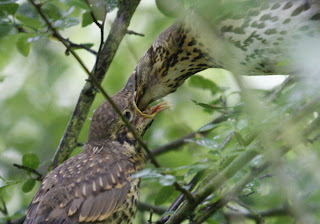
Thou Linnet! in thy green array,
Presiding spirit here today.
Beneath these fruit-tree boughs that shed
Their snow-white blossoms on my head
With brightest sunshine round me spread
Of springs unclouded weather..
W.Wordsworth.
Pied wagtail (motacilla alba yarrelli). it was amazing watching him catch insects in the field opposite the cottage. They are very agile on the wing. The 3 fledgling's tails bobbed up and down as they waited for the food to arrive. Eats flies, beetles, moths and other insects. Can have up to 3 broods a year. The female is duller in colour and the male is browner in the winter months.
Male Chaffinch (fringilla coelebs). While this male was singing in the tree the female (not as brightly coloured) was collecting nesting material. Feeds on grain and seed. Lays 3-6 eggs.
One of our most common birds, sadly not at home in my garden. They can gather in large numbers and amazingly regional dialect's have been recorded.
Oh, to be in England
Now that April's there,
And whoever wakes in England
Sees, some morning unaware,
That the lowest boughs and the brushwood sheaf,
Round the elm-tree bole are in tiny leaf,
While the chaffinch sings on the orchard bough
In England - Now!
R. Browning

Thrush fledgling being fed. I think it's a song thrush but I don't know for sure .They lay 2-6 eggs and can have 2 broods. Eats fruit, berries, worms, insects, larvae, seeds and snails.
Male Greenfinch (Carduelis chloris) The female is duller in colour. As a child I used to see lot's in the garden but no longer sadly so this was really nice. Fond of feeding from birdtables on seed fruit and berries. They nest in loose colonies and usually have 2 broods.Thou Linnet! in thy green array,
Presiding spirit here today.
Beneath these fruit-tree boughs that shed
Their snow-white blossoms on my head
With brightest sunshine round me spread
Of springs unclouded weather..
W.Wordsworth.
Pied wagtail (motacilla alba yarrelli). it was amazing watching him catch insects in the field opposite the cottage. They are very agile on the wing. The 3 fledgling's tails bobbed up and down as they waited for the food to arrive. Eats flies, beetles, moths and other insects. Can have up to 3 broods a year. The female is duller in colour and the male is browner in the winter months.
Sunday 30 May 2010
May 14th
14th - Sparrows dust bathing next door.
Andrew saw a fox down the road.
20th A hedgehog in garden.
Hedgehog (Ennaceus europacus)
Britain's only spiny mammal. Eats worms, caterpillars, eggs, slugs and snails. Hibernates in winter. Most babies are born in June - July. This one turns up about 10pm and eats the meal worms I'm putting out.
21st- A Squirrel scared a pigeon on the bird table today. He jumped from the fence.
22nd- 3 nights in row now the hedgehog has come to the garden. She I think because she is fat (I'm hopeful it's babies) is quite happy to have her photo taken.
23rd Garden is full of sparrows and starlings. The adults are collecting food and flying off to feed their young nearby.
26th - Sparrows in the loft have fledged and are being feed in the trees. The hedgehog is still coming for food.
28th Young Robin feeding itself on seed. Sunny but not too hot.
This has been a month of dandelions as they seem to be on every spare piece of grass.
29th - 3 fledgling starlings on fence. I watch as they pester their parents for food. The young robin seems to have adopted the sparrows - when they feed in the garden so does he. I wonder how long that will last?
Rainy end to the month.
Andrew saw a fox down the road.
20th A hedgehog in garden.
Hedgehog (Ennaceus europacus)
Britain's only spiny mammal. Eats worms, caterpillars, eggs, slugs and snails. Hibernates in winter. Most babies are born in June - July. This one turns up about 10pm and eats the meal worms I'm putting out.
21st- A Squirrel scared a pigeon on the bird table today. He jumped from the fence.
22nd- 3 nights in row now the hedgehog has come to the garden. She I think because she is fat (I'm hopeful it's babies) is quite happy to have her photo taken.
23rd Garden is full of sparrows and starlings. The adults are collecting food and flying off to feed their young nearby.
26th - Sparrows in the loft have fledged and are being feed in the trees. The hedgehog is still coming for food.
28th Young Robin feeding itself on seed. Sunny but not too hot.
This has been a month of dandelions as they seem to be on every spare piece of grass.
29th - 3 fledgling starlings on fence. I watch as they pester their parents for food. The young robin seems to have adopted the sparrows - when they feed in the garden so does he. I wonder how long that will last?
Rainy end to the month.
Thursday 13 May 2010
6th May
We have a very brave sparrow in the garden. She comes very close to me to get meal worms and, if I'm not there she lands on the door handle and looks into the conservatory as if to say where's my food? She has me very well trained feeding her on demand. As it turns out her nest is in our loft. Ahh. The babies fledged on the 26th. The one above is sitting on our fence waiting to be fed.
This one is being fed by mum.
"In busy mart and crowded street,
There the smoke-brown sparrow sits" E .Cooke
11th Conker trees in full flower. Goldfinch briefly in garden before going next door to eat the groudsel.
" I love to see the little Goldfinch pluck,
the groundsel's feathered seed;
And then in bower of apple-blossoms perched.
trim his gay suit and pay us with a song.
I would not hold him prisoner for the world.
J Hurdis"
Great tit , blue tit, sparrows, pigeons and starlings in garden today. Dunnock displaying fluttering behaviour as seen during mating and in fledgelings at feeding time.
12th - Hail fell today.
13th- Goldfinch feeding today, and a collared dove was fighting a pigeon twice his size. The fledgling sparrows are in the garden feeding.
Monday 3 May 2010
May 2010
1st - Cloudy but lots of visitors to the garden; goldfinch, sparrows, robin, magpie, pigeons, blue tits, great tits and collared doves. Day ends with a thunderstorm.
2nd - Dawn chorus weekend- |lay in bed with the window open so I could hear the bird song. I'm not very good at identifying the different songs but I do know the blackbird who was the loudest amongst the soup of song that rang through the air. Also heard the "teacher, teacher", of the great tit and the tawny owl. The male does the "twit" part while the female does the "twoo".
The male sparrows have fluffed up their tails and are fluttering them at the females in a courtship display along the fence.
May bank holiday we went to a nearby bluebell wood. The bluebells need another week to come into their own but we did see a jay.
Jay (Garrulus glandarius). Present all year in woodland. Eats acorns, eggs, insects and lizards. lays 3-6 eggs from April .
The Jay, the Pie, and even the boding Owl
That hails the rising moon, have charms for me.
William Cowper
We also saw wood anenome in flower, blue and whit bells and a fungi with bugs jumping about on it!
Wood anenome (Anemone nemorosa). Like the blue bell it makes most of the sunlight before the leaves block it out.
2nd - Dawn chorus weekend- |lay in bed with the window open so I could hear the bird song. I'm not very good at identifying the different songs but I do know the blackbird who was the loudest amongst the soup of song that rang through the air. Also heard the "teacher, teacher", of the great tit and the tawny owl. The male does the "twit" part while the female does the "twoo".
The male sparrows have fluffed up their tails and are fluttering them at the females in a courtship display along the fence.
May bank holiday we went to a nearby bluebell wood. The bluebells need another week to come into their own but we did see a jay.
Jay (Garrulus glandarius). Present all year in woodland. Eats acorns, eggs, insects and lizards. lays 3-6 eggs from April .
The Jay, the Pie, and even the boding Owl
That hails the rising moon, have charms for me.
William Cowper
We also saw wood anenome in flower, blue and whit bells and a fungi with bugs jumping about on it!
Wood anenome (Anemone nemorosa). Like the blue bell it makes most of the sunlight before the leaves block it out.
Monday 26 April 2010
20th April
20th - Saw a thrush while out driving today.
22nd Reappearance of goldfinch in garden.
25th- First flower on apple tree and first strawberry flower.
Sunny today we went to Kingsbury water park. We saw blue tits, great tits, sparrows, pied wagtail, various butterflies,great crested grebe, tuffed duck, mallards, mute swan, Canada geese and black headed gulls mating.
26th- Showery Cole tit and great tit in garden.
Cole tit (Prus ater)
Sexes are both alike. Lays 6-11 eggs. Feeds on insects and seeds.
"This tiny son of life; this spright"... Walter de la Mare
Great tit (Parus major)
Our largest tit and familiar in gardens. Lays 8-12 eggs. Eats seeds and insects.
"Teacher, teacher, teacher,. That's your song"...Robin Ivy
April ends with a day of sunshine and showers.
22nd Reappearance of goldfinch in garden.
25th- First flower on apple tree and first strawberry flower.
Sunny today we went to Kingsbury water park. We saw blue tits, great tits, sparrows, pied wagtail, various butterflies,great crested grebe, tuffed duck, mallards, mute swan, Canada geese and black headed gulls mating.
26th- Showery Cole tit and great tit in garden.
Cole tit (Prus ater)
Sexes are both alike. Lays 6-11 eggs. Feeds on insects and seeds.
"This tiny son of life; this spright"... Walter de la Mare
Great tit (Parus major)
Our largest tit and familiar in gardens. Lays 8-12 eggs. Eats seeds and insects.
"Teacher, teacher, teacher,. That's your song"...Robin Ivy
April ends with a day of sunshine and showers.
Sunday 18 April 2010
April 17th
17th/18th - A beautiful weekend ,heralded by a glorious dawn chorus. lots of flowers giving colour to the garden: forget-me-nots, pansies, aubretia, celandine, violets and last be not least the blossom on the tree.
Sweet Violet(Viola odorata)The flower of Aphrodite.
Forget-me-not
There are 2 stories of how the Forget-me-not got it's name:
A Knight and his love were walking together when the Knight fell into the river. As he fell he threw a handful of small blue flowers and shouted forget-me-not as he disappeared under the water.
Or
When God was naming the flowers in the garden of Eden he missed a tiny blue flower amongst the blooms. When he sat to admire his work he heard a little voice saying Forget-me-not.
Sweet Violet(Viola odorata)The flower of Aphrodite.
Forget-me-not
There are 2 stories of how the Forget-me-not got it's name:
A Knight and his love were walking together when the Knight fell into the river. As he fell he threw a handful of small blue flowers and shouted forget-me-not as he disappeared under the water.
Or
When God was naming the flowers in the garden of Eden he missed a tiny blue flower amongst the blooms. When he sat to admire his work he heard a little voice saying Forget-me-not.
Tuesday 13 April 2010
April 2010
"The Cuckoo comes in April,
he sings his song in May.
In the middle of June he changes his tune.
In July he flies away."
1st Sun and showers.
2nd - 2 robins at the meal worms. The bushes and trees are all in bud.
7th - The crows are building a nest in a large tree at the back of the garden. I watched as they flew in with twigs of assorted sizes finding each a place on the nest.
The phlox is in flower- bright pink against the gravel.
Lots of bird song and butterflies around. I must learn to identify them.
Heard a Tawny Owl last night.
13th Sparrows collecting nesting material.
Male blackbirds fighting over territory.
The robin has come down to eat the meal worms while I sit still in the garden.
Robin(Enthacus rubecula)
Both sesxes are alike and very aggresive. They lay 5-6 eggs and eat insects, worms, seeds, fruit and berries.
he sings his song in May.
In the middle of June he changes his tune.
In July he flies away."
1st Sun and showers.
2nd - 2 robins at the meal worms. The bushes and trees are all in bud.
7th - The crows are building a nest in a large tree at the back of the garden. I watched as they flew in with twigs of assorted sizes finding each a place on the nest.
The phlox is in flower- bright pink against the gravel.
Lots of bird song and butterflies around. I must learn to identify them.
Heard a Tawny Owl last night.
13th Sparrows collecting nesting material.
Male blackbirds fighting over territory.
The robin has come down to eat the meal worms while I sit still in the garden.
Robin(Enthacus rubecula)
Both sesxes are alike and very aggresive. They lay 5-6 eggs and eat insects, worms, seeds, fruit and berries.
Subscribe to:
Posts (Atom)

